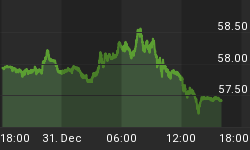Like a hand into a glove, today's Dow Jones Transportation Index (DJT) nearly identically emulates the nine-month lead in pattern which occurred on the Nasdaq in 1987 and culminated in the historically famous crash.
The DJT, a leading index, has traced the 1987 Nasdaq chart up to today's edge of a similar yawning precipice. The key to this event was the successful retest of Double Top resistance as indicated in my previous essay last week. That comparison was between the Qs and the Nasdaq from 1987, which did not decline as anticipated due to impressively good earnings from a few of the leading tech stocks, several of which had multiple downwardly revised estimates preceding earnings release. However it is important to consider that the Qs did not break out from the Double Top pattern either.
But there are two other leaders which did decline as expected: the DJT and the Russell 2000 Small Cap Index. This essay focuses on the DJT as it most closely follows the Nasdaq 1987 chart which indicates the anticipated decline.
Here is the famous Nasdaq 1987 chart which clearly shows the oscillators in a negative divergence to the Double Top and correctly indicated the decline to follow:

And today, observe how the Dow Transport's Double Top which produced the decline from Wednesday, 10/21 through Friday, 10/23 was indicated ahead of time by the oscillators on the DJT index in the same way as before the Crash of 1987.

Note something important about the crossovers of the MACD and ADX: they are happening at the same relative time frame as the Crash of 1987, that is they have occurred about half-way between the Double Top resistance and support, as shown by the black and dashed orange lines above, respectively.
Now observe the overlay of today's Dow Jones Transports with the Nasdaq 1987 chart.

What to look for here is a break through support as occurred in the 1987 Nasdaq chart. It's all downhill from there.
The Crash of 1987 was the defining moment in stock market history and was the impetus to have then president Ronald Reagan create the Working Group, also known as the plunge protection team (PPT). I believe they can draw out the market's crash, but not prevent it. The indices are not too big to fail, they're too big to effectively control.
Keep in mind that the role of a bull market is to keep you out all the way up until the top, whereas the role of a bear market is to keep you in all the way down until the bottom. Be aware of market psychology so as not to get trapped in either position. There are plenty of bear funds available to take advantage of an opportunity such as this, should you so choose.
I am not an investment advisor, so kindly do your own due diligence before making any investment decisions. I expect this should be over fairly quickly, as the guillotine cannot be improved upon. It's perfect just as it is.
















